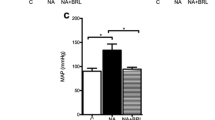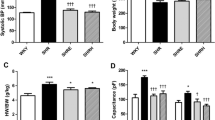Abstract
Heart failure is accompanied by electrolyte disturbance including reduced calcium and sodium in the extracellular milieu but increased calcium within cells, a phenomenon called “calcium paradox”. Aldosteronism is considered as part of this disorder. Aldosterone antagonism is known to reduce cardiac mortality on top of standard therapies such as antagonism of the renin–angiotensin-system. However, the effect of aldosterone on cardiac function under basal conditions and conditions more closely related to those seen in heart failure remains elusive. In order to address this question the function of isolated cardiomyocytes was determined as unloaded cell shortening. Cardiomyocytes were isolated from adult rat hearts and cultured for 24 h in the presence of aldosterone. Thereafter, cell shortening was determined in cells that were electrically paced (0.5–2.0 Hz). The effect of aldosterone on cell shortening was investigated under basal and maximal inotropic stimulation, preincubation with angiotensin II and myocytes from spontaneously hypertensive rats. The composition of the culture medium was modified according to the extracellular milieu found in patients with end-stage heart failure. Aldosterone increased cell shortening in a frequency-dependent way under basal conditions and conditions of low calcium. It potentiated the effect of β-adrenoceptor stimulation, increased the formation of oxygen radicals, and increased diastolic and systolic calcium. In conclusion, chronic exposure to aldosterone improves the function of cardiomyocytes under basal conditions and electrolyte disturbances that mimic the situation found in heart failure patients.








Similar content being viewed by others
References
Alsafwah S, Laguardia SP, Nelson MD, Battin DL, Newman KP, Carbone LD, Weber KT (2008) Hypovitaminosis D in African Americans residing in Memphis, Tennessee with and without heart failure. Am J Med Sci 335:292–297
Arakelyan KP, Sahakyan YA, Hayrapetyan LR, Khudaverdyan DN, Ingelman-Sundberg M, Mkrtchian S, Ter-Markosyan AS (2007) Calcium-regulating peptide hormones and blood electrolyte balance in chronic heart failure. Regul Pept 142:95–100
Benitah J-P, Vassort G (1999) Aldosterone upregulates Ca2+ current in adult rat cardiomyocytes. Circ Res 85:1139–1145
Boixel C, Gavillet B, Rougier J-S, Abriel H (2006) Aldosterone increases voltage-gated sodium current in ventricular myocytes. Am J Physiol Heart Circ Physiol 290:H2257–H2266
Chai W, Garrelds IM, Arulmani U, Schoemaker RG, Lamers JMJ, Danser AHJ (2005) Genomic and nongenomic effects of aldosterone in the rat heart: why is spironolactone cardioprotective? Br J Pharmacol 145:664–671
Chhokar VA, Sun Y, Bhattacharya SK, Ahokas RA, Myers LK, Xing Z, Smith RA, Gerling IC, Weber KT (2005) Hyperparathyroidism and the calcium paradox of aldosteronism. Circulation 111:871–878
Chun T-Y, Bloem LJ, Pratt JH (2003) Aldosterone inhibits inducible nitric oxide synthase in neonatal rat cardiomyocytes. Endocrinology 144:1712–1717
Fischer P, Hilfiker-Kleiner D (2007) Survival pathways in hypertrophy and heart failure: the gp130-STAT3 axis. Basic Res Cardiol 102:393–411
Hayashi H, Kobara M, Abe M, Tanaka N, Gouda E, Toba H, Yamada H, Tatsumi T, Nakata T, Matsubara H (2008) Aldosterone nongenomically produces NADPH oxidase-dependent reactive oxygen species and induces myocyte apoptosis. Hypertens Res 31:363–375
Jansen J, Gres P, Umschlag C, Heinzel FR, Degenhardt H, Schlüter K-D, Heusch G, Schulz R (2003) Parathyroid hormone-related peptide improves contractile function of stunned myocardium in rats and pigs. Am J Physiol Heart Circ Physiol 284:H49–H55
Kiyomoto H, Rafiq K, Mostofa M, Nishiyama A (2008) Possible underlying mechanisms responsible for aldosterone, mineralocorticoid receptor-dependent renal injury. J Pharmacol Sci 108:399–405
Ladilov Y, Efe Ö, Schäfer C, Rother B, Kasseckert S, Abdallah Y, Meuter K, Schlüter K-D, Piper HM (2003) Reoxygenation-induced rigor-type contracture. J Mol Cell Cardiol 35:1481–1490
Langer M, Lüttecke D, Schlüter K-D (2003) Mechanism of the positive contractile effect of nitric oxide on rat ventricular cardiomyocytes with positive force/frequency relationship. Pflügers Arch 447:289–297
Lee AH, Mull RL, Keenan GF, Callegari PE, Dalinka MK, Einsen HJ, Mancini DM, DiSesa VJ, Attie MF (1994) Osteoporosis and bone morbidity in cardiac transplant recipients. Am J Med 96:35–41
Maack C, O’Rourke B (2007) Excitation–contraction coupling and mitochondrial energetics. Basic Res Cardiol 102:369–392
Mano A, Tatsumi T, Shiraishi J, Keira N, Nomura T, Takeda M, Nishikawa S, Yamanaka S, Matoba S, Kobara M, Tanaka H, Shirayama T, Takamatsu T, Nozawa Y, Matsubara H (2004) Aldosterone directly induces myocyte apoptosis through calcineurin-dependent pathways. Circulation 110:317–323
McCarron DA, Yung NN, Ugoretz BA, Krutzik S (1981) Disturbances of calcium metabolism in the spontaneously hypertensive rats. Hypertension 3(Suppl 1):I-162–I-167
Mihailidou AS, Mardini M, Funder JW (2004) Rapid, nongenomic effects of aldosterone in the heart mediated by ε protein kinase C. Endocrinology 145:773–780
Mihailidou AS, Funder JW (2005) Nongenomic effects of mineralcorticoid receptor activation in the cardiovascular system. Steroids 70:347–351
Mufti S, Wenzel S, Euler G, Piper HM, Schlüter K-D (2008) Angiotensin II-dependent loss of cardiac function: mechanisms and pharmacological targets attenuating this effect. J Cell Physiol 217:242–249
Perrier R, Richard S, Sainte-Marie Y, Rossier BC, Jaisser F, Hummler E, Bénitah J-P (2005) A direct relationship between plasma aldosterone and cardiac L-type Ca2+ current in mice. J Physiol 569:153–162
Pitt B, Zannad F, Remme WJ, Cody R, Castaigne A, Perez A, Palensky J, Wittes J (1999) The effect of spironolactone on morbidity and mortality in patients with severe heart failure. Randomized Aldactone Evaluation Study Investigators. N Eng J Med 341:709–717
Rebsamen MC, Perrier E, Gerber-Wicht C, Benitah J-P, Lang U (2004) Direct and indirect effects of aldosterone on cyclooxygenase-2 and interleukin-6 expression in rat cardiac cells in cultures after myocardial infarction. Endocrinology 145:3135–3142
Rude MK, Duhaney T-AS, Kuster GM, Judge S, Heo J, Colucci WS, Siwik DA, Sam F (2005) Aldosterone stimulates matrix metalloproteinases and reactive oxygen species in adult rat ventricular cardiomyocytes. Hypertension 46:555–561
Schlüter K-D, Schreiber D (2005) Adult ventricular cardiomyocytes: isolation and culture. Methods Mol Biol 290:305–314
Stefanelli T, Pacher R, Woloszczuk W, Glogar D, Kaindl F (1992) Parathyroid hormone and calcium behavior in advanced congestive heart failure. Z Kardiol 81:121–125
Sun Y, Ahokas RA, Bhattacharya SK, Gerling IC, Carbone LD, Weber KT (2006) Oxidative stress in aldosteronism. Cardiovasc Res 71:300–309
Tastan I, Schreckenberg R, Mufti S, Abdallah Y, Piper HM, Schlüter K-D (2009) Parathyroid hormone improves contractile performance of adult rat ventricular cardiomyocytes at low concentrations in anon-acute way. Cardiovasc Res 82:77–83
Thomas M, Vidal A, Bhattacharya SK, Ahokas RA, Sun Y, Gerling IC, Weber KT (2007) Zinc dyshomeostasis in rats with aldosteronism. Response to spironolactone. Am J Physiol Heart Circ Physiol 2932:H2361–H2666
Wenzel S, Soltanpour G, Schlüter K-D (2005) No correlation between the p38 MAPK pathway and the contractile dysfunction in diabetic cardiomyocytes. Pflugers Arch 451:328–337
Yamamuro M, Yoshimua M, Nakayama M, Abe K, Shono M, Suzuki S, Sakamoto T, Saito Y, Nakao K, Yasue H, Ogawa H (2006) Direct effects of aldosterone on cardiomyocytes in the presence of normal and elevated extracellular sodium. Endocrinology 147:1314–1321
Acknowledgments
This study was supported by the Deutsche Forschungsgemeinschaft (SFB 547, project A1) and a grant given by the Rhön GmbH.
Author information
Authors and Affiliations
Corresponding author
Rights and permissions
About this article
Cite this article
Wenzel, S., Tastan, I., Abdallah, Y. et al. Aldosterone improves contractile function of adult rat ventricular cardiomyocytes in a non-acute way: potential relationship to the calcium paradox of aldosteronism. Basic Res Cardiol 105, 247–256 (2010). https://doi.org/10.1007/s00395-009-0059-6
Received:
Revised:
Accepted:
Published:
Issue Date:
DOI: https://doi.org/10.1007/s00395-009-0059-6




